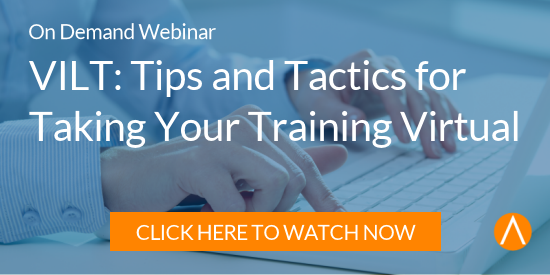Posted by Caveo Learning ● June 16, 2016
4 Ways for Subject Matter Experts to Participate in Training
 Subject matter experts are invaluable to those of us in the learning and development profession, helping us understand the complexities of the content and audience of our training initiatives. Oftentimes, due to a SME’s expertise in his or her content area, they are enlisted to deliver training. This can work well—if the SMEs are skilled in facilitation and training delivery. But what if they aren’t?
Subject matter experts are invaluable to those of us in the learning and development profession, helping us understand the complexities of the content and audience of our training initiatives. Oftentimes, due to a SME’s expertise in his or her content area, they are enlisted to deliver training. This can work well—if the SMEs are skilled in facilitation and training delivery. But what if they aren’t?
We know that lecturing through a hundred PowerPoint slides is not facilitation, nor is it training delivery. Delivering content to learners in a face-to-face setting takes skill, practice, and experience. Just because the SME has a vast amount of knowledge and experience in their area of expertise doesn’t automatically make them well suited for delivering training. Rather, take advantage of their skills for content clarity and definition, and rely on trained facilitators for the actual delivery of training.
It’s possible to leverage the SME’s talents in a way that enhances training, without entirely relinquishing training delivery. In doing so, you provide variety and engagement for your learners. This allows you to use the SME in ways that will allow them to shine—sharing their expertise and knowledge.
How to Help SMEs Shine in Training Delivery
Assuming the face-to-face training or instructor-led training includes elements that provide learning transfer for your audience, such as engaging activities, robust discussions, real-world scenarios, etc., allowing SMEs to participate in training can be an enhancement of these.
Panel of Experts
Your training may be on a topic that includes a larger pool of SMEs. If so, create a panel and bring them all in to share their experiences and lessons learned. Your panel could include three to five experts, depending on the timeframe you have available and scheduling. Panelists can share best practices, stories from the field, and more. We all know how valuable real-world stories are for learners in grasping content and solidifying it to their next days on the job. This panel segment can come after an interactive lecture or discussion segment, which can help to add engagement and enable learning transfer.
It’s wise to design this segment with some structure by crafting questions ahead of time; this is another area where the SMEs can provide value, as they identify the frequent questions asked by those new to the position or field. A panel is always enlivened by allowing audience members to ask their own questions, as well. Prepare your SMEs by informing them of likely questions ahead of time, as well as expectations on how the panel will be structured. This will help to rein in the over-talkers on your panel.
Q&A with the Expert
Similar to a panel of experts, you can also pull in a SME for an interview session. Providing just the one SME to the entire audience allows that SME to get more in depth in relation to their experience. Just as with the panel, you can craft questions ahead of time with the help of your SME, while also opening up the segment to the audience’s questions at the end. This Q&A session could follow a lecture-based segment, or it could instead fall just before a lecture, where the questions to the SME are in a specific area, drilling the focus into the content that will be learned next (a pseudo-flipped classroom).
Day-in-the-Life Training—Stories from the Field
 In addition to the vast amount of knowledge a SME has on a given topic, their experiences provide robust coloring to any training. Stories from the field help learners grasp content, so bring in a SME to share their story of a typical day—on the job or in the field. Day-in-the-life training is about more than the SME answering questions about content—it's about allowing the SME to tell their story. It could be their story since they started in the role (if time permits), or it could be a specific story relating to how the SME handled (or should have handled) a situation that relates back to the content. These stories are what is typically shared during those informal learning moments when employees are sharing stories over coffee or at the water cooler. In this situation, you are reshaping that informal moment and making it work within your structured training.
In addition to the vast amount of knowledge a SME has on a given topic, their experiences provide robust coloring to any training. Stories from the field help learners grasp content, so bring in a SME to share their story of a typical day—on the job or in the field. Day-in-the-life training is about more than the SME answering questions about content—it's about allowing the SME to tell their story. It could be their story since they started in the role (if time permits), or it could be a specific story relating to how the SME handled (or should have handled) a situation that relates back to the content. These stories are what is typically shared during those informal learning moments when employees are sharing stories over coffee or at the water cooler. In this situation, you are reshaping that informal moment and making it work within your structured training.
Coffee/Lunch with the Expert
Bringing in a SME during those “non-training” segments, like lunch or break periods, helps bring variety and value to the training overall. When a SME is invited to spend time with learners in a casual way, to “break bread” with fellow team members, connections and networking are added perks to the learning already occurring. Dialogue during this time is relatively open, but should still center on the content and the SME’s knowledge to be shared. The facilitator should be present when needed to help direct and redirect conversations, when applicable.
Added Bonuses of SME Involvement
Using SMEs in ILT segments as outlined above provides added bonuses. The biggest value-add is providing the learners engaging training and opportunities to ask relevant questions with an expert in the field. Another considerable bonus is the opportunity for the SMEs to show off their talents in a way that highlights their expertise and skills (as opposed to forcing them into the trainer role when they are not skilled in that area).
An additional bonus, if you plan for it ahead of time, is to capture video of the experience and stories the SMEs share as content documentation and for future repurposing. A video camera can be set to record from the back of the room during the panel discussions, Q&A sessions, and day-in-the-life segments. These videos can be spliced and reused to reinforce other training elements trainings (ILT, virtual ILT, eLearning, etc.), in different, and blended, training programs.
Working and collaborating with SMEs should be considered a bonus for us in the L&D industry. We should be diligent in using their time and talents wisely as we work to build a partnering relationship with with the SMEs. Leveraging SMEs in ways that allow their talents and knowledge to be shared with others is another way to build that partnership and show the overall value of L&D.
Topics: Training and Facilitation

